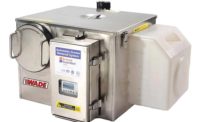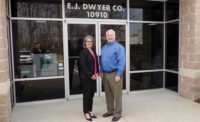Experience is the word that keeps manufacturers of low-flow commercial faucets up at night.
The experience an end-user has with a low-flow commercial faucet is paramount because these manufacturers admit they are reaching the limit on how low they can go with water flow.
“We joke that at some point the world is going to require a waterless faucet,” says Adam Molberger, a commercial product manager with Chicago Faucets. “With the way all the limitations are and the desire to save water nobody takes into consideration what does that mean? You can put the flow rate down to 0.35 gpm, but is the user going to feel like they’re washing their hands properly? Or more importantly, are they going to be at the faucet twice as long because they have less water to work with?”
Sloan Product Line Manager for Faucets Andrew Warnes says a faucet can grade out swimmingly in the lab, but if the user hates his or her experience with it in the restroom then it’s a disaster.
“The first factor we consider is the quality of the end-user experience,” he says. “A technically perfect faucet is a failure in our minds if the customer is not satisfied when using it, which is more likely to occur as flow rates are reduced.”
For Zurn, a low-flow faucet is just one part of the commercial restroom experience and it’s critical to optimize its role in the process.
“As you’re washing your hands with the lower flows coming into play, are you able to interact with the water?” asks Bob Carter, a Zurn commercial faucet product manager. “Are you having a good experience with the soap dispensers that are part of the fixture? We’re really cautious of having an ergonomics bubble. Providing a systems solution and creating an integrated handwashing experience with a unified countertop, basin, soap dispenser and faucet (is the next step of low-flow faucets).”
Hands off
Zurn’s Carter says the public’s growing desire to touch less in a bathroom is one trend that pushes the low-flow commercial faucet market. The company focuses on “paired-performance,” which includes how its faucets work in conjunction with a sink basin, soap dispenser and the rest of the bathroom.
“People are worried about hygiene,” he says. “We’ve seen an increase in sensor technology with low-flow faucets. We’re focused on systems. Surprisingly, low-flow faucets splash more because we’re pushing more pressure. We’re able to play with the basins to get the splash dynamic down and then water doesn’t splash on the counter.”
Zurn took 18 months to develop its TempReady low-flow commercial faucet, which is expected to be available this summer. The TempReady was designed to consider stagnant water to eradicate any potential Legionella concerns in hotels, health-care and other facilities.
“One of the concerns we have is we’re maybe not moving enough water. Then that water becomes stagnant,” Carter notes. “By bringing the mixing valve closer to the source, we’re able to mix water closer to the tap and have less stagnant water.”
Someone to watch over
Warnes believes regulatory requirements have been the constant driver for the low-flow commercial market.
“A genuine desire for water savings beyond regulatory requirements appears to be a lesser driver,” he begins, “though voluntary third-party certification programs which reward water savings are steadily growing.”
Warnes notes all Sloan commercial faucets comply with or exceed the water-efficiency requirements for CalGreen, California CEC, LEED v4 and other standards. The company developed a website to help with the selection process that features a dropdown list of compliances and certifications popping up on the page.
“We’re seeing more and more governing bodies requiring low flow,” Chicago Faucets’ Molberger states. “In a number of cities, any government project complies to some form of LEED, which requires a low-flow faucet.”
Because of these requirements, Molberger notes Chicago Faucets is reevaluating how the production of low-flow faucets will need to change.
“We’re trying to shift the paradigm on development,” he says. “What do we really need in a faucet if we know they are only going to go to a 0.35- or 0.5-gpm unit?”
Warnes is impressed with engineers’ consistency in demands for what they need in a low-flow commercial faucet. “Reliability always is number one,” he notes. “That’s followed by, in order, durability, quality of customer service and cost.”
When Zurn hits the road to promote a new low-flow faucet or any new product, Carter says the company will sit down with engineers to ask about any concerns they have. Zurn is looking for feedback and that is pushing the manufacturer to think big-picture.
“They’re more than willing to tell you about the problems they have had with this or that,” he says. “For example, they’re afraid that water on the countertops will lead to water on the floor. That leads to a slip and fall. Then lawyers are involved. Keeping that water contained to where it’s supposed to be is not something you get just sitting at your desk designing the product. You have to go out and experience it.”
Molberger says Chicago Faucets market outreach allows for engineers to come to the manufacturer and partner to create a personalized low-flow commercial faucet.
“We do allow for an engineer to come in and configure a product,” Molberger says. “If they are looking for something specific that they need and it’s not available, we will work with them to set up the product they wanted with a 0.35-gpm or other low-flow outlet. We are in constant communication to show them what is coming.”
Gathering info
While working with engineers and end-users, Sloan has developed opportunities to collect data to learn more about how to create products in the future, as well as end-user traits.
“We work together with customers and end-users to get their opinions,” Warnes states. “(We) have even set up increasingly lower-flow test stations to figure out where customers might reject faucet designs because flows are too low for them to achieve what they feel is an acceptable hand-washing experience. Since a large number of our designs actually collect and store usage data, we can tell if there is a difference between what end users say they want and what they actually do. Hand hygiene is a remarkably important and personal experience for our customers, so we listen very carefully to what they have to say.”
Molberger says Chicago Faucets starts its data collection in-house with a low-flow commercial faucet setup at its Des Plaines, Illinois, headquarters. They’ll have workers test it out and provide feedback. They also bring in people from the outside for additional notes before taking it into field testing.
“When we did our EQ Series faucets we brought in people because we knew we were onto something,” he says. “The next month we took it to focus groups and on test runs.”
So where does the low-flow commercial market go from here? It doesn’t go lower, according to Molberger. It gets wider.
“We’re not really sure how much of a lower flow you can really get to,” he says. “The 0.35-gpm is, in a number of ways, just a trickle. We’re trying to augment the water conservation element because I’m not sure you’re going to dive much deeper than 0.35. But, you’ll see that flow rate more readily available than it has been in the past. Anything that comes out you’ll get that flow rate option when in the past it was limited to a handful of products.”








